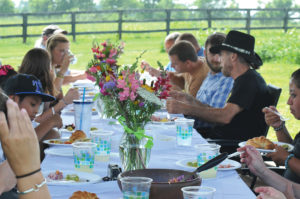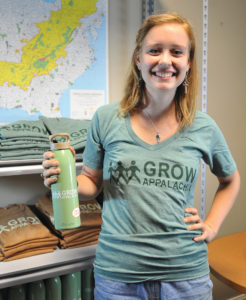Working in the midst of poverty, unemployment, and malnutrition, Grow Appalachia has transformed the way many families live in just four years. By providing families with resources and skills to create individual and community gardens, Grow Appalachia has increased the availability of healthy, affordable food to thousands of households and has brought community members together who share
an interest in hard work and good food.
Grow Appalachia’s director, David Cooke, ’82, reflected on the program’s mission, “We believe in meeting people where they are, working with them to build upon their strengths, and because of this, we have been able to confront and address many of the major problems associated with food insecurity.”

Though Appalachia’s overall economic conditions have shown some improvement since the 1960s, the recent recession hit the region hard. The unemployment rate in central Appalachia remains well above 10 percent, and chronic underemployment and workforce withdrawal rates are much higher. Per capita income in central Appalachia is 30 percent lower than the national average, and upwards of 25 percent of families fall under the federal poverty line, according to the Appalachian Regional Commission’s data. Grow Appalachia supports this poorest part of the region, where basic needs too often go unmet, by helping people grow as much of their own food as possible.
Grow Appalachia was founded in 2009 through the combined work of Berea College and John Paul DeJoria, co-founder and CEO of John Paul Mitchell Systems (JPMS) and founder of JP’s Peace, Love & Happiness Foundation. The idea for the program formed when DeJoria shared his desire to combat food insecurity in the U.S. with Tommy Callahan, Senior Vice President of Training and Development at JPMS.
A native of Harlan County, Kentucky, Callahan knew the economic challenges
Appalachian families face every day, and he suggested to DeJoria that Appalachia would be the perfect place to begin addressing food insecurity. Callahan introduced DeJoria to Berea College, suggesting that Berea was well positioned to help organize and implement the effort that DeJoria had begun to imagine.

DeJoria soon became determined to give the people of Appalachia the choice to eat well by combining his philanthropy with their hard work. Callahan initially contacted Berea’s Joanne Singh, who is the associate vice president for development. Singh, in collaboration with Chad Berry, at that time the director of the Loyal Jones Appalachian Center and now Berea’s academic vice president, and David Cooke, who was working as director of the Appalachian Fund and program coordinator of Entrepreneurship for the Public Good (EPG), brought DeJoria a proposal for how the College could help make his ideas a reality. Having recognized the need for healthier, homegrown food within the region for many years, Cooke was interested when this opportunity arose. Cooke stated, “It had struck me that there were fewer and fewer gardens even though malnutrition, food security, and hunger issues continued to be more striking every year.” The development of Grow Appalachia would provide him with the chance to change that trend.
30 counties in Kentucky, Tennessee, Virginia, and West Virginia.
400 individual gardens and 41 community gardens.
320,000 pounds of food shared among at least 9,000 people.
During the first year, DeJoria and Cooke worked together to develop a program designed to meet the needs and build on the strengths of existing community centers in Appalachia. Cooke sought out partnerships with nonprofit organizations that demonstrated fiscal responsibility and an interest in food security issues. Even as Grow Appalachia has expanded, those standards have stayed consistent. The program now serves a diverse population of participants, ranging from Girl Scouts to the elderly and from the disabled to the incarcerated.

used to promote Grow Appalachia.
In four years, the geographic reach and food production capacity of Grow Appalachia have expanded quickly. In its first year, Grow Appalachia supported four partner sites, reached more than 2,800 people, and produced approximately 120,000 pounds of fresh food. Since then, the program has expanded into more than 30 counties in Kentucky, Tennessee, Virginia, and West Virginia. In 2012, the last full year on record, Grow Appalachia had more than 400 individual gardens and 41 community gardens producing 320,000 pounds of food shared among at least 9,000 people. The program has also begun supporting families interested in other types of food production, including eggs and honey. Along with fresh food and new skills, Grow Appalachia provides its communities with full- and part-time jobs, employing men and women as gardening coordinators, field workers, and site supervisors.
Focusing on providing education, resources, and tools, Grow Appalachia has engaged all types of people, introducing them to new and more efficient ways to raise food and, in many cases, doubling or even tripling the average crop yield. “We have changed the way people garden in these areas,” said Cooke. “We have brought organic gardening to areas where it was once unheard of.”
Grow Appalachia has achieved some of its success based on the development of new techniques like the household scale high tunnel, an unheated greenhouse that helps extend the growing season. This innovative design allows families to put homegrown food on the table twelve months a year. The Natural Resources Conservation Service has accepted Grow Appalachia as a vendor, and Berea College is now providing Grow Appalachia with space to build and sell these specialized high tunnels.

Grow Appalachia’s educational component complements the technical assistance and material resources offered to participants. Each partner site is required to teach a yearly minimum of five education classes on gardening, food preservation, and heart-healthy cooking, which participants are required to attend. “Folks really enjoy these classes,” Cooke said. “They are social events for a lot of communities. People love coming to the classes. They get to see people, they have potlucks, they get to learn something new, and they share what they know.”


